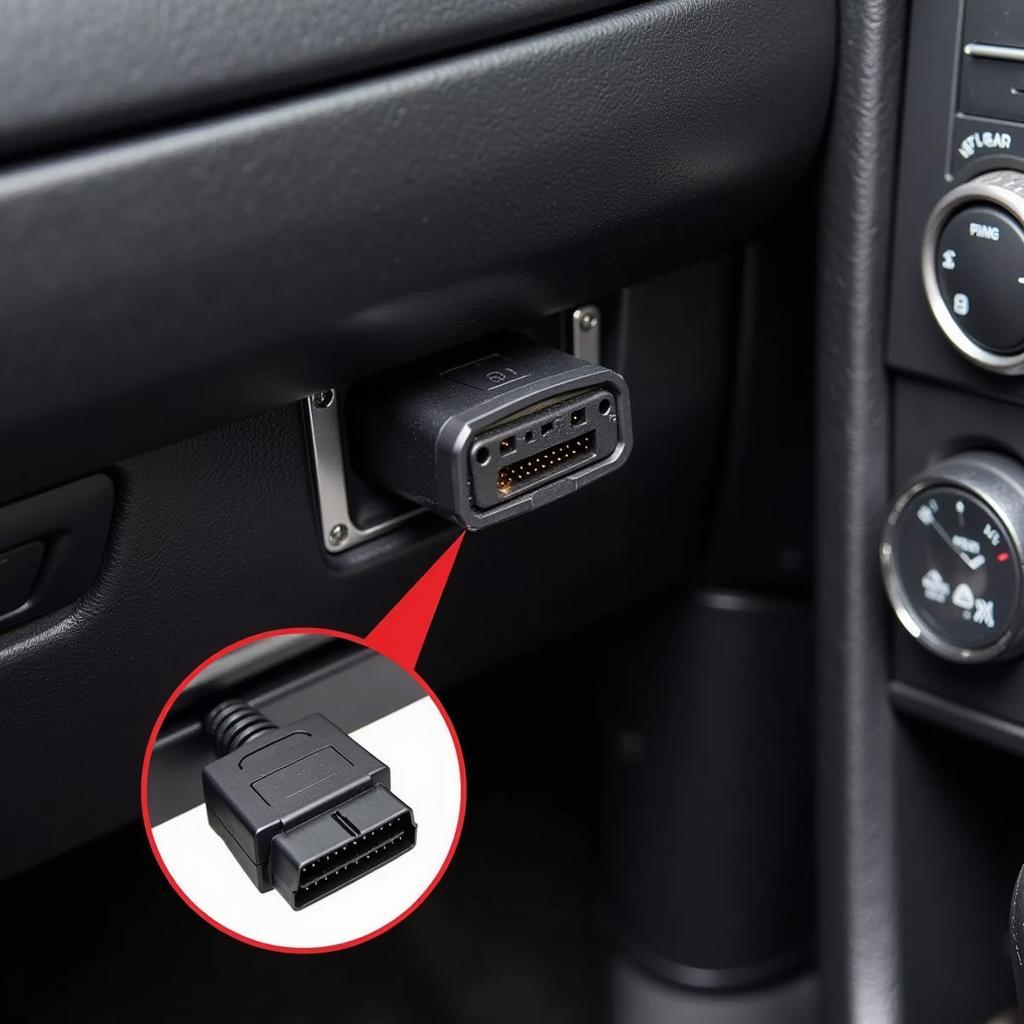Obd Car Diagnostics have revolutionized the way we understand and maintain our vehicles. No longer are we left in the dark when a warning light flashes on the dashboard. With OBD car diagnostics, a wealth of information about your car’s health is just a scan away. But what exactly is OBD, and how can it help you?
Demystifying OBD: A Look Under the Hood
OBD, or On-Board Diagnostics, is a standardized system that allows external devices to access your car’s computer system and retrieve diagnostic information. Think of it as your car’s very own black box, constantly monitoring and recording data from various sensors throughout the vehicle.
This data, when accessed through an OBD car diagnostics tool, can reveal a plethora of information about your car’s engine, transmission, emissions system, and more.
 OBD Port Location
OBD Port Location
OBD Car Diagnostics: More Than Just Reading Codes
While OBD is most commonly associated with reading and clearing those pesky check engine lights, its capabilities extend far beyond that. Here are just a few ways OBD car diagnostics can benefit you:
- Pinpointing Problems: OBD scans can identify the root cause of a problem, saving you time and money on unnecessary repairs.
- Preventing Major Issues: Regular OBD car diagnostics can detect minor issues before they snowball into expensive repairs.
- Improving Performance: By monitoring parameters like fuel efficiency and emissions, OBD can help you optimize your car’s performance.
- Empowering DIY Maintenance: OBD empowers car owners to take control of their vehicle’s maintenance, allowing for informed decisions about repairs.
Choosing the Right OBD Car Diagnostics Tool
With a plethora of OBD car diagnostics tools available, choosing the right one can seem daunting. Here’s a quick rundown:
- Basic Code Readers: These affordable devices primarily read and clear error codes.
- Bluetooth Scanners: These connect to your smartphone, offering advanced features like live data streaming and graphing.
- Professional-Grade Scanners: Used by mechanics, these provide comprehensive diagnostics, programming capabilities, and access to manufacturer-specific data.
Unlocking the Power of OBD: A Step-by-Step Guide
Using an OBD car diagnostics tool might seem intimidating, but it’s surprisingly simple. Here’s a basic guide:
- Locate the OBD Port: Usually found under the dashboard on the driver’s side.
- Connect the Scanner: Plug the OBD car diagnostics tool into the port.
- Turn on the Ignition: Turn the key to the “on” position without starting the engine.
- Read the Codes: Follow the scanner’s instructions to read any stored diagnostic trouble codes (DTCs).
- Interpret the Codes: Look up the meaning of the codes online or in your scanner’s manual.
- Clear the Codes: After addressing the issue, use the scanner to clear the codes.
OBD Car Diagnostics: The Future of Car Maintenance
OBD car diagnostics have come a long way since their inception. As cars become increasingly sophisticated, so too will OBD technology. We can expect to see even more advanced features, increased connectivity, and seamless integration with smartphones and other devices.
OBD car diagnostics empower car owners with knowledge and control over their vehicles. By understanding how to use this technology effectively, you can ensure your car stays healthy, runs smoothly, and stays out of the repair shop for longer.
FAQs about OBD Car Diagnostics
Q: Can I use any OBD scanner on my car?
A: Most OBD scanners are compatible with a wide range of vehicles. However, it’s essential to check the scanner’s compatibility with your car’s make, model, and year before purchasing.
Q: What does a check engine light mean?
A: A check engine light can indicate a wide range of issues, from minor emissions problems to more serious engine malfunctions. An OBD car diagnostics scan can pinpoint the exact cause.
Q: Can I fix my car based solely on OBD codes?
A: While OBD codes provide valuable clues, it’s crucial to use them in conjunction with other diagnostic procedures and your own mechanical knowledge before attempting any repairs.
Q: How often should I perform an OBD car diagnostics scan?
A: It’s recommended to perform a scan at least once a year or whenever you notice any unusual behavior from your vehicle.
Need Help with OBD Car Diagnostics?
For expert guidance and support with your car diagnostic needs, reach out to our team at DiagFixPro. We offer a comprehensive range of resources, reviews, and expert advice to help you make informed decisions about your car’s health.
Contact us today via WhatsApp at +1(641)206-8880 or email us at [email protected]. Our dedicated customer support team is available 24/7 to assist you.

Leave a Reply